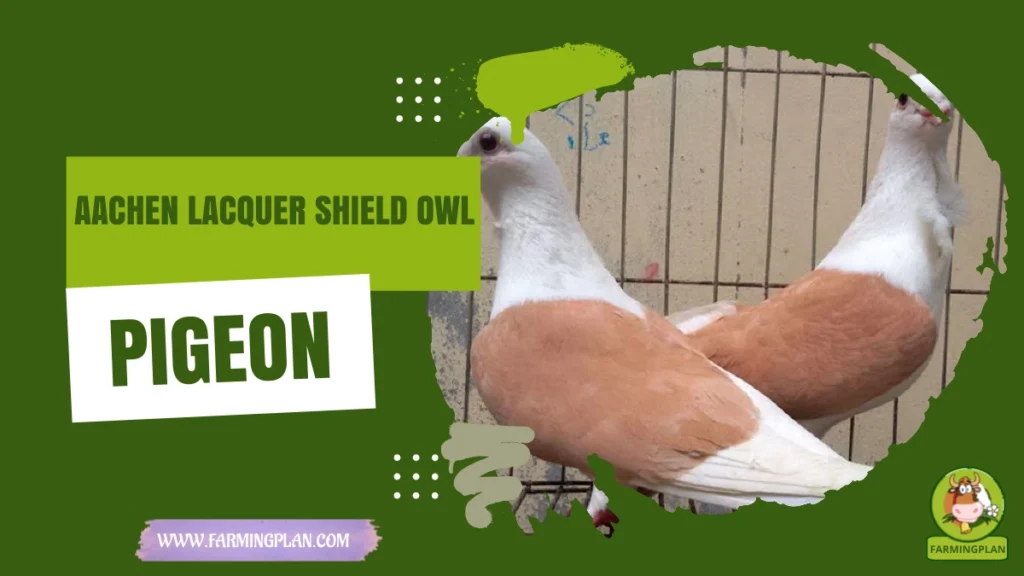The Kathiawari horse is a remarkable breed with a deep cultural and historical significance in India, especially in Gujarat. Known for its muscular build and unique markings, this breed thrives in tough desert conditions, making it one of the most resilient and intelligent horses in the world. Often referred to as a “desert war horse,” the Kathiawari horse has stood the test of time, continuing to captivate horse lovers and breeders alike. This article delves into the breed’s history, characteristics, temperament, diet, and how to care for them, offering all the essential information for potential owners, breeders, and enthusiasts.
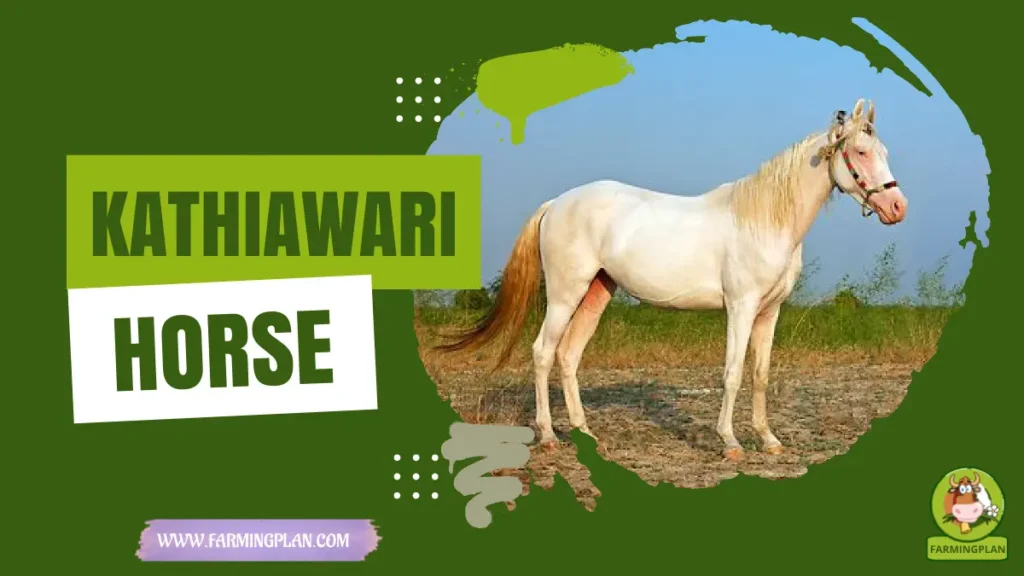
History & Origin of the Kathiawari Horse
The Kathiawari horse traces its roots to the arid regions of Gujarat, India, where it evolved to withstand extreme desert conditions. Originating from ancient Arabian horses, the breed was developed to be a war horse, capable of carrying riders across the harshest terrains. The Kathiawari’s history can be traced back to the days of the Rajputs, who used them in battles due to their agility and stamina. Over time, these horses became essential not only in warfare but also in various agricultural tasks, such as plowing fields and transporting goods.
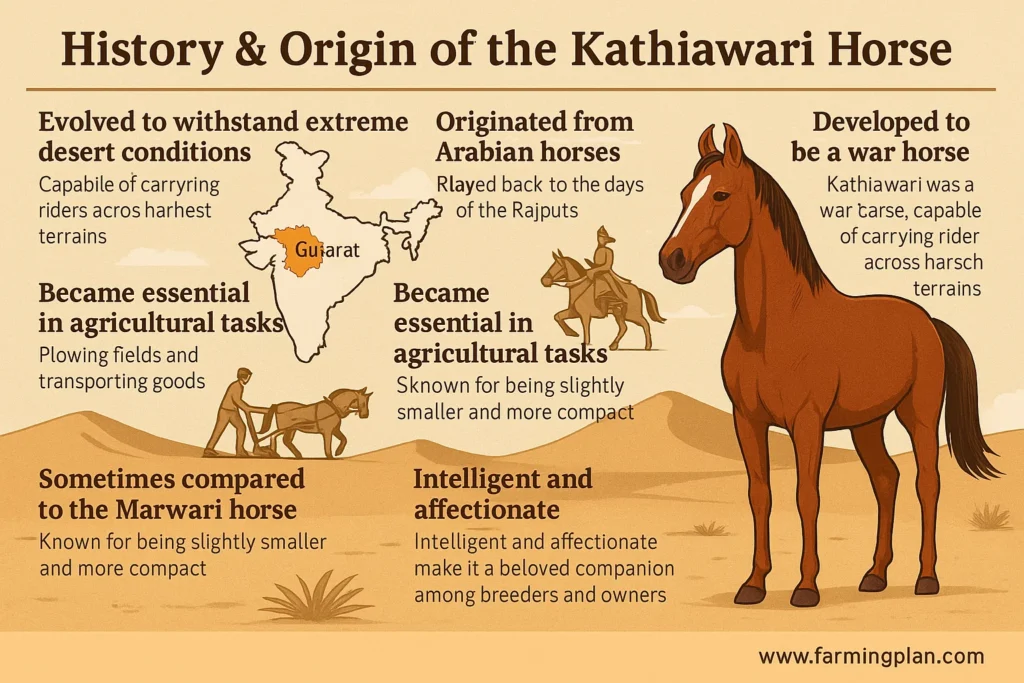
The breed’s development was closely intertwined with the region’s needs for a strong, hardy, and dependable animal. While Arabian horses played a significant role in the Kathiawari’s evolution, it is the breed’s adaptation to the desert and its unique markings that set it apart. The Kathiawari horse is sometimes compared to the Marwari horse, another iconic Indian breed, but it is known for being slightly smaller and more compact. The Kathiawari’s characteristics, such as its intelligence and affection for its owners, make it a beloved companion among breeders and owners.
Characteristics of the Kathiawari Horse
Kathiawari horses are known for their compact and muscular bodies, standing between 14.5 and 15.2 hands in height. Their short, sturdy legs and powerful bodies allow them to maneuver swiftly through rough terrains, making them ideal for desert environments. The breed’s distinctive appearance includes a dry, refined head with a large, expressive eye and a prominent dorsal stripe running down its back, which is one of its most defining features. Kathiawari horses have a variety of coat colors, though the most common are black and chestnut.
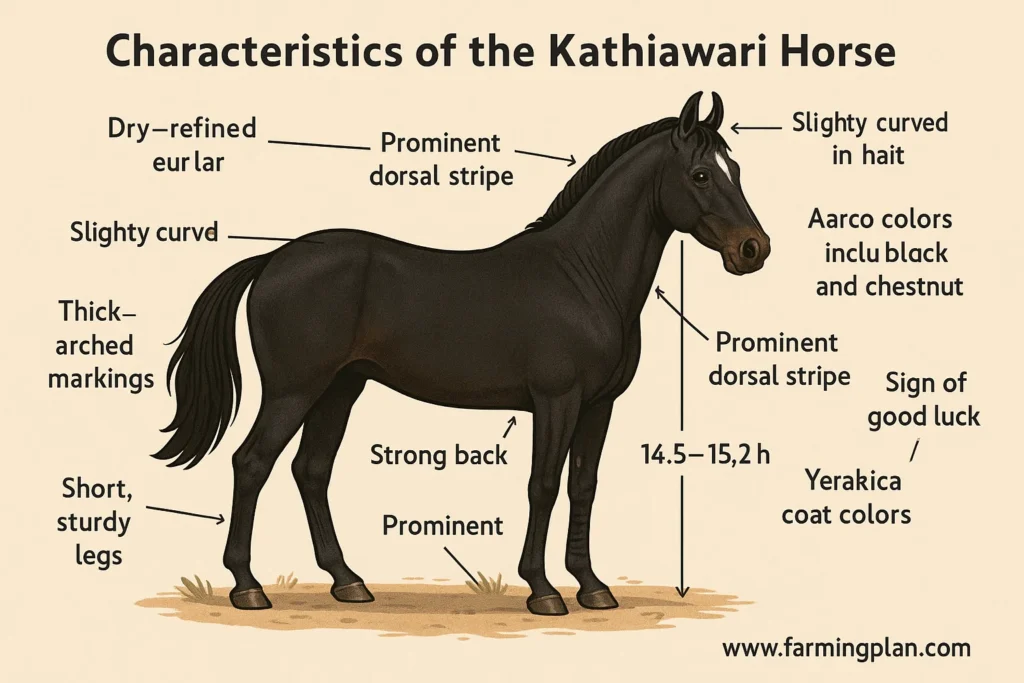
Their thick, arched necks, strong backs, and deep chests contribute to their ability to carry heavy loads, making them not only good riding horses but also reliable working animals. Another unique feature is the zebra-like markings on their legs, which are often seen as a sign of good luck. Their ears are one of the breed’s most distinctive traits. Kathiawari horses have slightly curved ears, and they often touch each other at the tips, which gives them a unique appearance. The breed’s overall look is muscular yet elegant, with a physique built for endurance and agility.
Nature and Temperament of the Kathiawari Horse
Kathiawari horses are known for their high-spirited and intelligent nature. They are incredibly affectionate towards their owners, forming strong bonds that make them excellent companions. Despite their energetic temperament, these horses are also gentle and obedient, making them ideal for both experienced horse owners and beginners. In terms of behavior, Kathiawari horses are known to be alert and responsive, traits that make them excellent for riding and trekking. They are highly trainable, which is why they are often used in various activities, including police work, racing, and trekking.
Their strong instinct for protection also makes them ideal guard animals, adding to their appeal among farmers and ranchers. However, like most high-spirited horses, Kathiawaris require consistent training and care. They thrive in environments where they are given regular exercise and interaction, ensuring that they are happy and well-adjusted. Their intelligence makes them quick learners, but they also need an owner who is patient and able to provide structure and discipline.
Read more: Icelandic Horse: Why This Stunning Breed Might Surprise You
Food & Diet for the Kathiawari Horse
Feeding a Kathiawari horse requires an understanding of its specific dietary needs, especially given its origins in the harsh desert conditions. These horses are used to a diet consisting primarily of forage, including grass, hay, and sometimes grains, depending on the available resources. Since they have evolved to function on minimal rations, it’s important to feed them in moderation and provide a balanced diet to maintain their health and strength. Kathiawari horses need access to fresh water at all times, especially since they are accustomed to hot and arid environments.
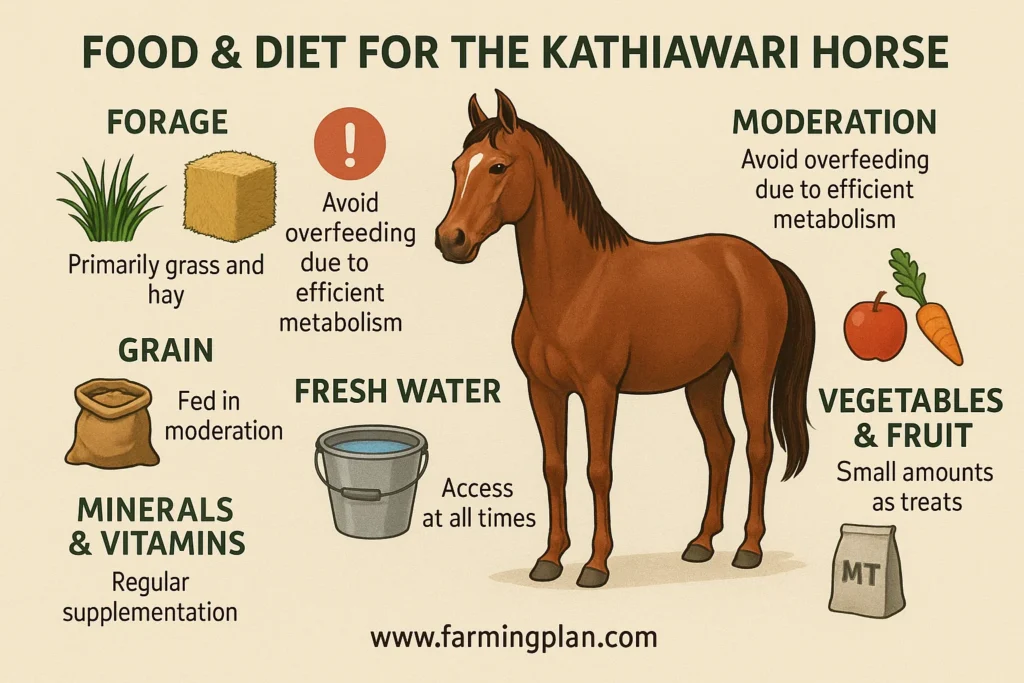
Overfeeding or providing excessive grain can lead to health issues, so their diet should be carefully managed. Fresh vegetables and fruits can be given as treats, but only in small amounts to avoid disrupting their digestive system. Another important aspect of their diet is the addition of minerals and vitamins to support their overall health. Regular supplementation of these nutrients ensures that Kathiawari horses have the energy and stamina to thrive in both working and recreational settings.
Usage and Purpose of the Kathiawari Horse
Kathiawari horses are incredibly versatile animals, used for a variety of purposes due to their strength, stamina, and gentle temperament. Historically, they have been used in warfare as desert war horses, prized for their ability to carry soldiers across harsh desert landscapes. In modern times, they are still used for similar purposes, including police work and other forms of mounted patrol. In addition to their work-related uses, Kathiawari horses are popular as riding horses. They are especially favored for trekking and endurance riding due to their resilience in difficult terrain.
Their calm nature also makes them suitable for beginners, as they tend to be less temperamental than some other breeds. Moreover, Kathiawari horses have been bred for their beauty and strength, often showcased in horse shows and exhibitions. They are a staple in cultural traditions, particularly in Gujarat, where they are considered a symbol of strength and nobility.
Read more: Marwari Horse: The Royal Breed That Stands Out with Curved Ears and Courage
Special Features of the Kathiawari Horse
Kathiawari horses are unique in several ways. One of the most notable features is their distinctive markings, including zebra-like stripes on their legs and a prominent dorsal stripe along their backs. These markings are considered lucky and are highly prized among horse enthusiasts. Their high endurance and agility in rough terrain also set them apart from other breeds. The Kathiawari is a hardy animal, built to withstand the harsh conditions of the desert.
This breed’s muscular build and stamina are complemented by its strong bond with its owners, making it both a reliable working animal and a cherished companion. Another special feature is their unique ear formation. Kathiawari horses have curved ears that often touch at the tips, which is an uncommon trait among many horse breeds. This unique characteristic gives them an adorable, endearing appearance.
The Kathiawari horse is not just a breed, it’s a legacy, a symbol of strength and endurance in the harshest terrains.
Health Issues & Prevention in Kathiawari Horses
Like all horse breeds, Kathiawari horses are prone to certain health issues. Common problems include respiratory conditions, especially in areas with extreme temperatures, and hoof problems due to their active lifestyle and terrain. Regular hoof care is essential to prevent lameness and other related issues. Kathiawaris are also susceptible to colic, a digestive issue that can affect horses of any breed.
Owners should be vigilant about their horse’s feeding schedule and avoid sudden changes in their diet. Regular veterinary care is crucial to monitor and address any health issues before they become serious. Preventive care for a Kathiawari horse includes routine vaccinations, parasite control, and keeping their living environment clean and free of hazards. Grooming is another important aspect of maintaining their health, as it helps improve circulation and keeps their coat shiny and healthy.
Read more: Tennessee Walking Horse: Why This Breed is Perfect for Beginners & Experienced Riders
Step-by-Step Care Guide for Kathiawari Horse
The “Step-by-Step Care Guide for Kathiawari Horse” offers essential tips for properly caring for this resilient breed. It covers stable setup, feeding, grooming, exercise, training, and veterinary care, ensuring your Kathiawari horse stays healthy, strong, and well-adjusted.
Step 1: Preparing the Stable
Preparing the Stable A well-prepared stable is crucial for your Kathiawari horse’s comfort and safety. The stable should be spacious enough for the horse to move freely, as they need room to stretch and turn around. The minimum recommended space for a single horse is about 10 feet by 12 feet, but more space is always better. Ensure that the stable has proper ventilation to prevent respiratory problems. Poor ventilation can cause dust build-up, which can lead to respiratory infections or allergies in horses.
The floor should be made of solid material, such as concrete or packed dirt, and covered with bedding like straw or wood shavings to absorb moisture and keep the area dry. Keep the stable clean by regularly removing manure and wet bedding to prevent bacterial growth and ensure your horse’s health. Be sure to check for any sharp objects or nails that could cause injury to your horse. The stable should also be protected from extreme weather, so a roof to shield from rain and the sun is essential. A safe, well-maintained stable ensures that your Kathiawari horse stays healthy and comfortable.
Step 2: Feeding and Nutrition
Feeding and Nutrition Kathiawari horses have adapted to the harsh desert conditions of Gujarat and thrive on a simple yet nutritious diet. Their primary food source should be fresh forage, such as high-quality hay and grass. Hay should be free from mold and contaminants, and grass should be pesticide-free. Ensure that your horse has access to forage throughout the day, as horses are natural grazers and need to eat small amounts of food frequently. While fresh forage is their main diet, you may need to supplement with grains, especially if your Kathiawari is in training or working hard. However, it’s important to limit the grain intake, as overfeeding can cause digestive issues like colic.
Fresh vegetables, such as carrots and apples, can be given as treats, but only in small amounts to avoid digestive upset. Your horse should always have access to fresh, clean water. Since Kathiawari horses are accustomed to desert conditions, hydration is key to keeping them healthy, especially during hot weather. Be sure to monitor their water intake and provide electrolytes if necessary to maintain proper hydration levels.
Step 3: Grooming and Hoof Care
Grooming and Exercise Daily grooming is essential for the health and well-being of your Kathiawari horse. Grooming helps to remove dirt, sweat, and loose hair, and also gives you the opportunity to inspect your horse for any injuries or signs of illness. Use a curry comb to loosen dirt and a stiff brush to remove it, paying special attention to areas like the legs, tail, and underbelly. Make sure to clean their hooves every day as well to prevent any debris from causing infection or injury. Regular exercise is just as important as grooming for your Kathiawari horse’s health.
These horses are known for their stamina and energy, and they require daily physical activity to stay fit and happy. Depending on your horse’s activity level and training, exercise can include daily walks, light trotting, or even endurance riding. Kathiawari horses are strong and resilient, and regular exercise helps to maintain their muscle tone, agility, and overall health. A well-exercised horse is not only physically fit but mentally stimulated. This helps prevent boredom, reduces stress, and improves their overall temperament, making them better companions and working animals.
Step 4: Training and Exercise
Training and Socialization Training is vital for the Kathiawari horse, as they are intelligent and responsive to structured routines. It’s important to start training early and be consistent with commands and expectations. Begin with basic ground manners, such as leading and standing still, before advancing to more complex tasks like riding or working. The use of positive reinforcement, such as treats or praise, works best with this breed, as Kathiawari horses respond well to encouragement rather than punishment. Kathiawari horses are also very social animals, and socialization is an important part of their training.
Expose your horse to different environments, sounds, and people in a calm and controlled manner. Gradually introduce them to new experiences, whether it’s another animal, a new setting, or new tasks, to build their confidence and reduce anxiety. Socialization helps them stay well-adjusted and calm in a variety of situations, making them more reliable as working or riding horses. Consistent training not only helps your Kathiawari horse learn useful skills but also builds trust and strengthens the bond between you and your horse. With patience and persistence, your horse will thrive in a structured and social environment.
Step 5: Veterinary Care
Veterinary Care Regular veterinary care is essential for maintaining the health of your Kathiawari horse. Schedule an annual check-up with a trusted veterinarian to monitor your horse’s overall health and detect any potential issues early. During the check-up, the vet will perform routine tests, check the heart rate, respiration, and general condition of your horse, and administer necessary vaccinations, such as tetanus and influenza, to protect against common equine diseases. Parasite control is also an essential aspect of equine care. Kathiawari horses, like all horses, are susceptible to internal and external parasites, including worms and lice.
Work with your veterinarian to establish a deworming schedule, which may need to be adjusted depending on the horse’s living conditions and environment. Regular dental care is another important part of their health. Horses’ teeth continuously grow and wear down, and any overgrowth or infection can lead to difficulty eating or discomfort. Lastly, don’t neglect hoof care. Hoof problems are common in horses, especially those that are active or work on hard terrain. Regular trimming, cleaning, and inspection of hooves help prevent injuries and infections. If you notice any signs of lameness, discomfort, or infection, consult your veterinarian immediately.
Expert Tips & Best Practices for Kathiawari Horse Care
- Tip 1: Make sure to give your Kathiawari horse plenty of exercise in the form of both groundwork and riding.
- Tip 2: Keep their environment clean to prevent infections, especially in the hooves.
- Tip 3: Regularly check their coat for any unusual signs of skin conditions or parasites.
Where to Buy a Kathiawari Horse
Kathiawari horses can be found in various breeding farms across India, especially in Gujarat. The Kathiawari Horse Society of India and Porbandar Horse Breeders Association are reliable sources for purchasing these horses. Prices vary depending on factors such as age, training, and breeding, with prices typically ranging from ₹50,000 to ₹1,50,000 in India.
FAQ
What is the average height of a Kathiawari horse?
Kathiawari horses typically range between 14.5 to 15.2 hands in height, making them a compact but muscular breed.
Are Kathiawari horses good for beginners?
Yes, their calm and affectionate nature makes them suitable for beginners, provided they are trained properly.
What do Kathiawari horses eat?
They primarily feed on grass, hay, and occasionally grains, supplemented with fresh water and vegetables.
Where can I buy a Kathiawari horse?
Kathiawari horses are available through breeders, especially in Gujarat, India. You can also check the Kathiawari Horse Society of India for reputable sellers.
How long do Kathiawari horses live?
Kathiawari horses typically live for about 25 to 30 years with proper care.
Conclusion
The Kathiawari horse is a strong and resilient breed from Gujarat, India, known for its endurance, agility, and loyal nature. Adapted to harsh desert conditions, it excels in trekking, police work, and farm tasks. With its muscular build and calm temperament, the Kathiawari forms deep bonds with owners and thrives with proper care, including a balanced diet, regular exercise, grooming, and veterinary support. This blend of strength, beauty, and loyalty makes it a prized companion for many years.


